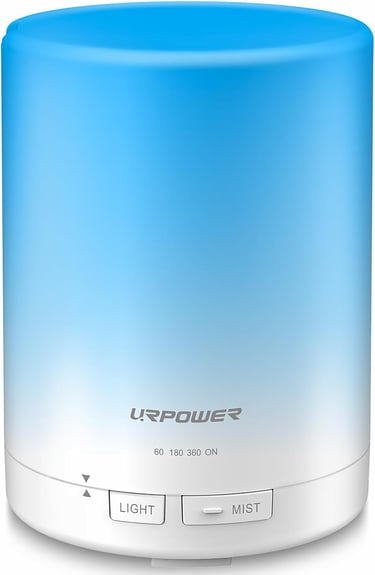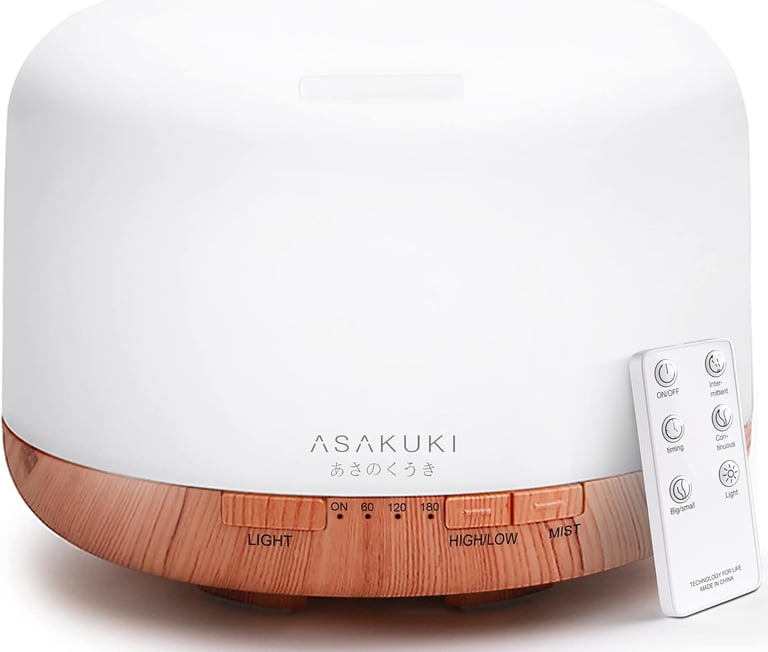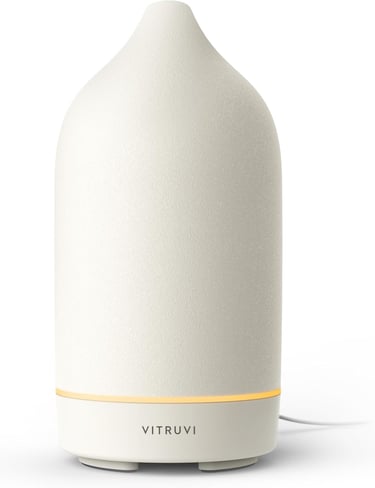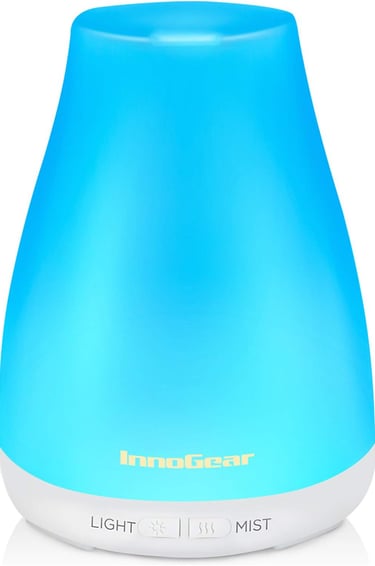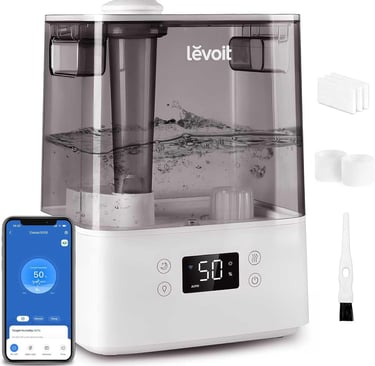Our 2025 Picks: 5 Best Diffusers for Home Oil DIY Setups on Amazon
Looking for the best diffusers for you home oil blends? We list out our 5 best diffuser picks that we think work best for home-made blends
ACCESSORIES
6/16/20258 min read
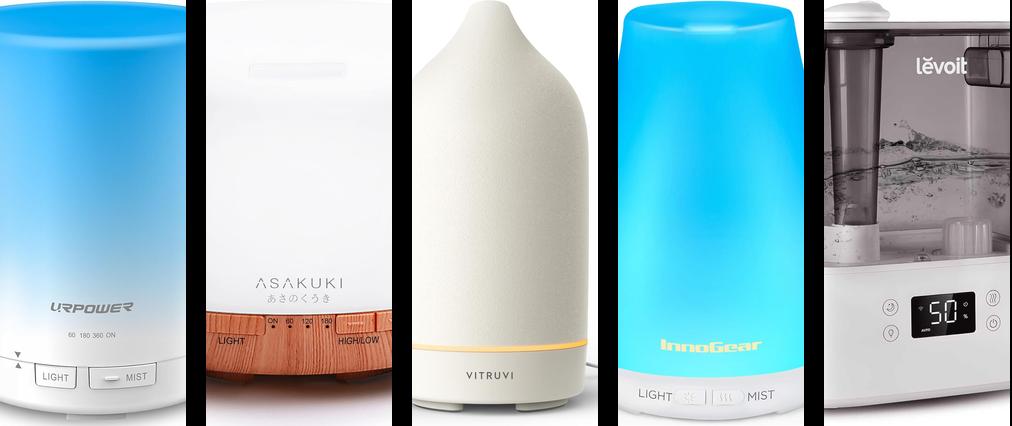

If you’re hunting for the “best diffusers for home oil”, you’re in the right place. I've spent the past five years tinkering with blends, troubleshooting mist that barely shows up, and, yes, maybe even accidentally flooding a night-stand or two. What follows is the five-unit lineup that I personally would buy again, ordered from simplest to most advanced. Every pick is in stock on Amazon as of the date of this post.
What you should look for in diffusers for home-made oils
The first question I ask myself before pouring a DIY blend into any machine is, “Will this atomizer survive a thicker, less filtered liquid?” Most home-made essential oils, or, to more accurately describe it, infused oils, still carry microscopic plant fibers, trace waxes, and a higher proportion of carrier‐fatty acids than the high-vacuum–distilled concentrates you buy in dark 10 ml bottles from the store. Those extra solids and lipids may smell wonderful, but they scrape across ultrasonic plates and gum up the tiny air nozzles in diffusers. For that reason, ultrasonic diffusers with wide, top-fill reservoirs and easily replaceable plates are usually the safest play. They use a ceramic disc that vibrates water and oil into a cool mist; any residue is easy to see and wipe off with vinegar and a cotton swab. Nebulizing diffusers, by contrast, atomize undiluted oil through a glass capillary; they produce the richest aroma but clog quickly when the liquid carries sediment, so they make sense only if you can fine-filter your blend which is not easy to do. So look for ultrasonic diffusers.
Because home infusions often ride on heavier carriers like olive, jojoba, fractionated coconut, the blend’s viscosity runs higher than a pure commercial essential oil. Higher viscosity means it slides down plastic walls slowly and can pool on the surface of the water. I've experimented with comparing a diffuser's mist output on home-made and commercial oils. Almost every time, the mist of the former is lesser than the latter. That’s why a diffuser with variable mist strength and an intermittent (“30 s on/30 s off”) mode is gold: you can start on the gentler setting, let the oil disperse, then spike it if the room still feels flat. Think of mist volume as a throttle. Too much vapor too fast simply wastes your precious DIY batch and leaves oily condensate on nearby furniture (this is real annoying to clean up). What I've found is that a more steady, moderate plume allows the scent molecules time to separate from the water micro-droplets and hang in the air. Also, you won't see oil condensate on nearby surfaces doing it like this.
In homemade oils, water is your friend. It buffers the ultrasonic plate of the diffuser, keeps temperatures low so the terpenes don’t scorch, and prevents straight‐oil contact that would otherwise shorten the plate’s life. Aim for a 5–8 drop ratio per 100 ml water until you learn how potent your infusion really is; homemade oils often smell milder than commercial ones because they contain fewer volatile compounds per milliliter. If you need more punch, double the drops only after verifying the diffuser’s manual allows that load. Keep a lint-free cloth nearby, wipe the reservoir nightly, and accept that DIY fragrance comes with the extra minute of maintenance.
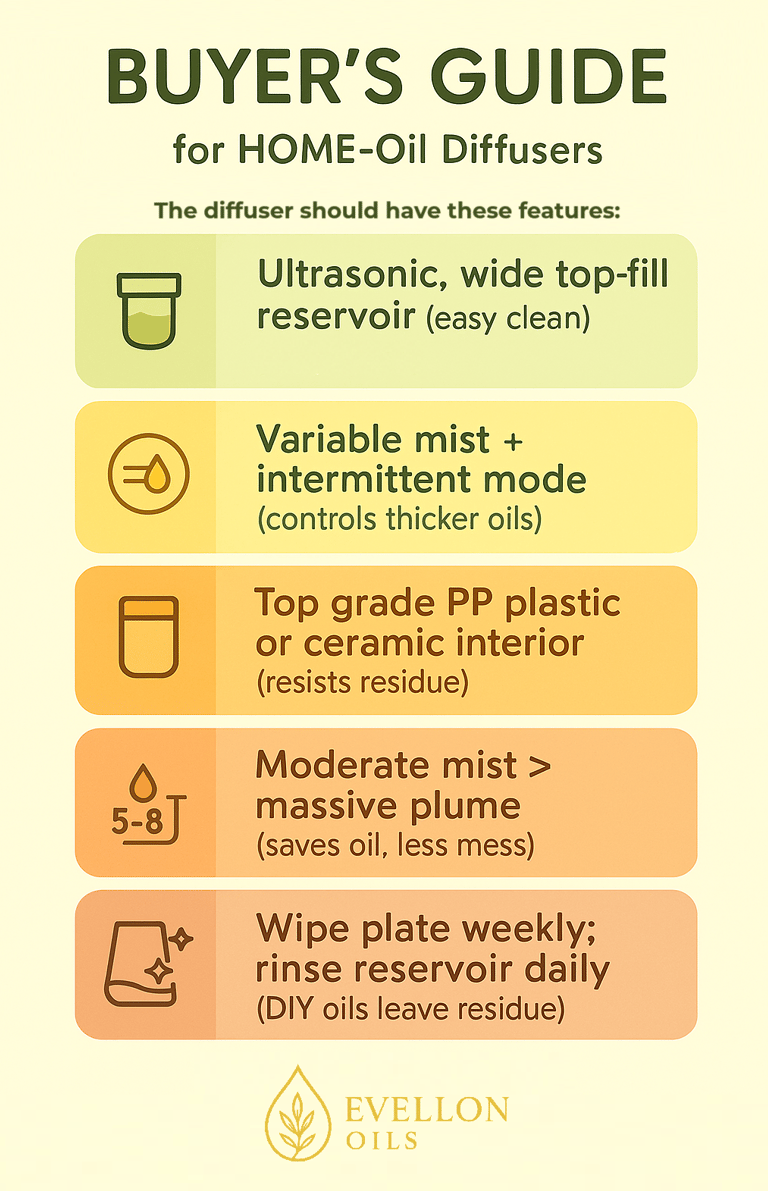

Our Top Diffuser Picks for Home-Oils
Now that you have that out of the way, let's get on with my picks.
When readers message me, “What diffuser should I start with if I don’t even know whether I’ll keep up the habit?” this is the one I'd recommend. URPOWER’s second-gen 300 ml unit looks plain, but I’ve clocked hundreds of hours on mine and the thing still works perfectly. The four timer buttons (1 h, 3 h, 6 h, and continuous) sit right on the face. Runtime is 6–7 hours on normal output, creeping toward ten if you drop to the weaker mist, which is plenty for an evening wind-down or overnight humidifying. The 7-color LED ring is fun but not blinding; I leave it on low teal as a bedside night-light. I still think it is a gimmick, but it is occasionally useful if you don't already have a bed light. Clean-up is equally no-drama: a quick rinse plus a cotton-swab swipe around the ultrasonic plate once a week works well with my home oils.
Because the reservoir is polypropylene, I’m comfortable experimenting with heavier blends. I even went as far as a 30-drop eucalyptus bomb and need not worry about plastic degradation. Although, I would definitely not recommend going that far (way too strong!). Pop the lid, measure directly with a kitchen scale if you’re that precise, and you can dial in repeatable recipes. It also has a nice auto-shut-off which means the diffuser dies gracefully when you forget to top it up, which I do more than I’d like to admit.
Cons:
LED ring can’t be dimmed all the way to “off” without killing the mist—annoying for pitch-black sleepers.
The lid’s silicone gasket stretches after a year or so; mist output dips until you replace it (a US$3 part, but extra hassle).
Matte plastic stains if you leave citrus oils sitting overnight; a vinegar soak fixes it, but still. (NOTE: this doesn't really affect the smell, you don't have to clean it)
After a few weeks you may want something you don’t have to refill so frequently. The ASAKUKI’s 500 ml “five-in-one” model. The nickname comes from its humidifier, diffuser, night-light, timer, and remote-control functions rolled into one shell. The big win for me is the fan: at <23 dB, you'll barely even hear it if you have the AC or ceiling fan on (perfect for bedrooms). The remote is infrared, not Wi-Fi, but from ten feet away I can kill the light without leaving the couch. This is pretty convenient, but I find myself misplacing it all the time so I often just use the buttons on the machine.
The half-liter tank lets you run longer dilution experiments. I sometimes load 400 ml water, 12 drops grapefruit, and 8 drops bergamot, then set the “intermittent” program to see how scent throw evolves as the water level falls. The oil never feels over-concentrated, and the plastic interior wipes clean even after dense resinous mixes. If you want to gift a diffuser to the person who complains their last one was “too noisy” or “too small,” this is my default suggestion. It is also pretty well made in terms of material and structure.
Cons:
Plastic shell can pick up a faint “new vinyl” smell the first week; rinse with baking-soda water to speed off-gassing.
Yes, the Vitruvi Stone costs more than a casual shopper expects, but the matte-ceramic shell looks like a sculptor’s bud vase and never picks up that cloudy patina cheaper plastics do. Capacity is only 90 ml, so it basically forces you to refresh water and oil daily. If you are super detailed, you would see this as a hidden benefit because stale standing water is the number-one cause of “my diffuser smells weird” emails that I get. Two modes live under a single button: a 4-hour continuous burst and an 8-hour intermittent cycle (30 seconds on, 30 seconds off). Either comfortably scents my 400 sq ft living room.
Because the inner reservoir is food-grade plastic topped by a ceramic cloak, you can run heady base-note experiments (think myrrh or vetiver) without the shell absorbing odors. Bonus: Vitruvi sells replacement lids as well so you don't have to throw it out if it breaks. If aesthetics matter as much as function and you’re okay with the premium, this checks every box. Definitely one of the best-looking and sturdy diffusers on the market. The matte ceramic design is really nice to look at and feel.
Cons:
Pricey: you’re paying as much for aesthetics and build quality as for functionality.
Single-button interface cycles through every mode before shutting off, can be a little annoying. But if you're into minimalist designs, then this is a pro.
The InnoGear’s small footprint (roughly a coffee mug) slips into carry-ons or dorm desks where outlets are prime real estate. Despite its size, the ultrasonic plate pushes out a surprisingly dense mist that blankets 100-250 sq ft. It's definitely enough for a hotel room, office cubicle, or the bathroom. Two mist modes let you pick 3–4 hours of continuous run or 6–8 hours of half-on half-off bursts.
Like the ASAKUKI, noise is rated under 23 dB, but because the shell is thinner, you’ll hear a gentle burble. It's not unpleasant, more like a tiny tabletop fountain.
This is the diffuser I use for “will this recipe smell terrible?” trials. The low water volume means fewer wasted essential-oil drops if the blend flops. I keep a Sharpie nearby and scribble mini-recipes on blue masking tape stuck to the underside, so future me remembers that 5 drops ylang-ylang plus 2 drops pine was…not a vibe. The little LED band cycles seven colors and can switch off entirely. I don't use that a lot, but it could be helpful when you just want a wisp of lavender during the night.
Cons:
Thin shell amplifies burbling. If you hate white-noise, this might not be for you.
Power cable exits from the side, so it won’t sit flush against a wall outlet shelf.
Capacity so small that thicker DIY oils can float, clogging the plate unless you stir with a toothpick first.
A 2-in-one machine. Diffuser and humidifier at the same time. If you’ve ever thought, I wish my diffuser could also handle winter humidity levels, this Levoit smart model is works fine. The six-liter tank dwarfs everything else on this list and runs up to 60 hours, automatically toggling output via built-in humidity sensing. The VeSync app (Android/iOS) lets you schedule on/off cycles, adjust target humidity, and drop the device into Alexa or Google Home routines. For instance, “Run peppermint mist at 8 AM” right after your alarm triggers. While the app can definitely have some improvements, it is still really useful and I use it all the time.
There’s no separate oil cup; instead, you add 8–12 drops directly onto a cotton aroma pad in the base, which keeps oil out of the ultrasonic chamber. Scent isn’t quite as punchy as a dedicated diffuser, but for background fragrance plus serious humidification, the trade-off rocks. Cleaning is painless: the top-fill lid comes off easily, so washing isn't really difficult. I would definite go for this if your not really too into the nitty gritty of essential oils, and are into the convenience of use instead. Also, another plus is that it is BPA free.
Cons:
Cotton aroma pad system mutes scent compared to direct-water diffusers; fine for background, weak for that "wow" effect with the smell.
App requires account login for some reason; if you hate cloud logins, skip it.
Full tank weighs over 13 lb.

